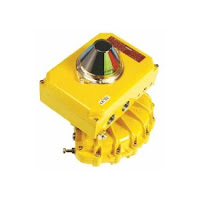 |
| Features of the Kinetrol EL positioner (click on image for larger view). |
The Kinetrol EL is one of the valve automation industries best performing electro-pneumatic positioners available. It combines the precision and adaptability of a digital electronic control circuit with the smoothness and efficiency of Kinetrol's proven proportional servo valve, to give the best available 4-20mA positioning performance from rotary pneumatic actuators.
To compliment this unbeatable performance, the EL combines the easiest available setup procedure, easiest access to all functions and options, easy connectivity, and a compact all-metal housing, unique easy-set isolated angle retransmit, and limit switch options inside the same enclosure.
The EL positioner is designed to smoothly and precisely drive a rotary or linear actuator to a position set by the 4-20 mA input signal, and then accurately hold it there until the signal changes.
Inside the EL, a microprocessor in the loop powered 4-20 mA positioner circuit reads signal via one channel of a 12-bit A-D convertor, reads the position voltage from tie pot via the second channel of the A-D convertor, and compares the two. If an error between desired position and actual position exists, the EL changes it's output to the servo valve in order to drive the actuator in the direction required to eliminate the error.
In sync with the movement of the actuator, the feedback pot voltage changes, and the microprocessor continually calculates how to adjust the servo valve in order to guide the actuator accurately into position. Because the servo valve is a fully proportional device, it can be adjusted precisely and smoothly to slow the actuator to a stop exactly at the required position. Programmed in the microprocessor is an advanced algorithm that allows this critical dynamic valve adjustment to be made correctly, giving optimal results with any actuator/load combination. Slow or fast responding, high friction or low friction, high inertia or low inertia, all can be optimized by PGAIN and DAMP parameters via the positioner circuit pushbuttons. The 12-bit A-D conversion gives the amazing resolution of approximately 1/40 of a degree angular.
For more information, contact Kinetrol USA by calling 972-447-9443 or visit their web site at https://kinetrolusa.com.



